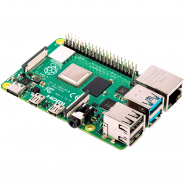- Em promoção!
- -3,00 €
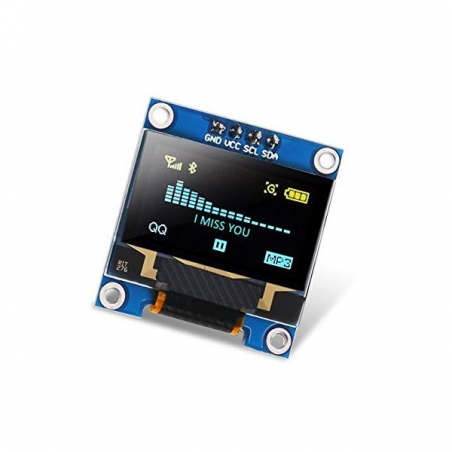








Este módulo de display OLED é pequeno de apenas 0,96 polegadas na diagonal com uma resolução 128x64. Ele funciona sem luz de fundo, ou seja, em um ambiente escuro, a luz d o display OLED é mais visivel em comparação com os LCD.
Este OLED é de 2 cores, amarelo e azul. O amrelo está presente numa pequena faixa no topo do OLED e o restante é azul.
DESCRIÇÃO EM PORTUGUÊS BREVEMENTE DISPONÍVEL
Se tiver alguma dúvida neste produto não hesite em contactar-nos.
*Atenção: as imagens são meramente ilustrativas.
Se tiver alguma dúvida neste produto não hesite em contactar-nos.
*Atenção: as imagens são meramente ilustrativas.
This OLED display module is small, only 0.96” diagonal, it is made of 128x64 individual yellow and blue OLED pixels, each one is turn on or off by the controller chip.
It works without backlight, that is, in a dark environment OLED display is higher compared to that of LCD display you will like the miniature for its crispness.
The Driver chip of this OLED is SSD1306, which is compatible with IIC communication. So this module can be controlled by I2C.
That is, except the VCC and GND, 2 wires would be needed when using 4-wires I2C mode.
There is also a simple switch-cap charge pump that turns 5v into a low voltage drive for the OLEDs, making this module the easiest ways to get an OLED into your project.
Features:
OLED self-luminous, no backlight
Size: 0.96”
Driver IC: SSD1306
Voltage: 3.3V-5V DC
Viewing angle: > 160°
High resolution: 128 x 64
Working Temperature: -30°C~70°C
Display: 2 rows of yellow, 6 rows of blue
Module Size: 27mmx 27mm x 4mm
Screen material: glass, need good protection
I2C Interface:
GND: Ground
VCC: 3.3V~5V
SCL: I2C Serial Clock (UNO: A5; MEGA: 21)
SDA: I2C Serial Data (UNO: A4; MEGA: 20)
Applications:
MP3, MP4, watch
Head-mounted displays
Meters and other intelligent instruments
The 0.96" OLED runs on SSD1306 controller with a resolution of 128 x 64 or 128 x 32 pixels. Moreover, it can use both SPI and I2C busses. My device only has four pins on it:


It is actually monochrome (single color) only. Some models like mine has a yellow filter on top, hence the color you see on the picture above. If you want to display colors, go for the SSD1331-based tiny OLED display.
Here's the rest of the specifications for the 0.96" OLED display:
Adafruit provides a library to be used with SSD1306-based OLED displays. This works with the Adafruit GFX library so you need to have that also. The library provides an example (go to File -> Examples -> Adafruit SSD1306 -> ssd1306_128x64_i2c) that shows all the capabilities of the library.
Note that you have to edit the SSD1306.h file (located at Documents -> Arduino -> Libraries -> Adafruit SSD1305) to match which OLED model you have. Go to lines 72 to 74 and find this section:
|
1
2
3
4
5
|
-----------------------------------------------------------------------*/
// #define SSD1306_128_64
#define SSD1306_128_32
// #define SSD1306_96_16
/*=========================================================================*/
|
If your display is the 128 x 64 version, comment out the 2nd line and uncomment to first line:
|
1
2
3
4
5
|
-----------------------------------------------------------------------*/
#define SSD1306_128_64
// #define SSD1306_128_32
// #define SSD1306_96_16
/*=========================================================================*/
|
Here's a simple example that displays text:
|
1
2
3
4
5
6
7
8
9
10
11
12
13
14
15
16
17
18
19
20
21
22
23
24
|
#define OLED_RESET 4
Adafruit_SSD1306 display(OLED_RESET);
#if (SSD1306_LCDHEIGHT != 64)
#error("Height incorrect, please fix Adafruit_SSD1306.h!");
#endif
void setup() {
display.begin(SSD1306_SWITCHCAPVCC, 0x3C); // initialize with the I2C addr 0x3C (for the 128x64)
display.display();
delay(2000);
display.clearDisplay();
display.setTextSize(1);
display.setTextColor(WHITE);
display.setCursor(0,0);
display.println("Hello, world!");
display.display();
delay(2000);
}
|
You might have noticed the Adafruit logo popping out every boot. This is because whoever created the library cleverly embedded the logo on the buffer array. This array loads every time you call display.display() for the first time. To remove the logo, open the Adafruit_SSD1306.cpp file and change each byte in the buffer array to 0x00.
Produtos Associados
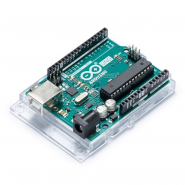
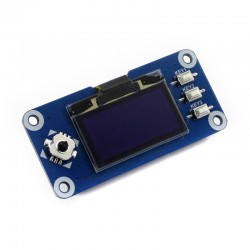
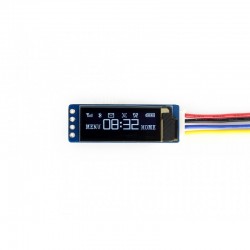

Este módulo de display OLED é pequeno de apenas 0,96 polegadas na diagonal com uma resolução 128x64. Ele funciona sem luz de fundo, ou seja, em um ambiente escuro, a luz d o display OLED é mais visivel em comparação com os LCD.
Este OLED é de 2 cores, amarelo e azul. O amrelo está presente numa pequena faixa no topo do OLED e o restante é azul.

